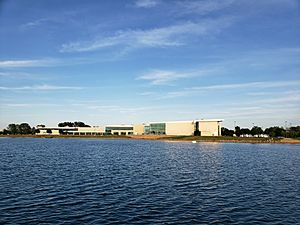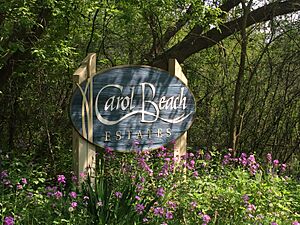Pleasant Prairie, Wisconsin facts for kids
Quick facts for kids
Pleasant Prairie, Wisconsin
|
|
|---|---|
|
Village
|
|

Location of Pleasant Prairie in Kenosha County, Wisconsin
|
|
| Country | |
| State | |
| County | Kenosha |
| Area | |
| • Total | 33.69 sq mi (87.25 km2) |
| • Land | 33.38 sq mi (86.45 km2) |
| • Water | 0.31 sq mi (0.80 km2) |
| Elevation | 696 ft (212 m) |
| Population
(2020)
|
|
| • Total | 21,250 |
| • Density | 630.18/sq mi (243.31/km2) |
| Time zone | UTC-6 (Central (CST)) |
| • Summer (DST) | UTC-5 (CDT) |
| ZIP Code |
53158
|
| Area code(s) | 262 |
| FIPS code | 55-63300 |
| GNIS feature ID | 1583935 |
Pleasant Prairie is a village in the state of Wisconsin, in the United States. It is located in Kenosha County, right on the southwestern shore of Lake Michigan. In 2020, about 21,250 people lived here.
The village is just south of the city of Kenosha and north of the Illinois border. Even though it's closer to Milwaukee, it's considered part of the Chicago metropolitan area. Two well-known places in Pleasant Prairie are the RecPlex and the Chiwaukee Prairie.
Contents
History of Pleasant Prairie
The area where Pleasant Prairie is now was once a busy place for Native Americans long before pioneers arrived. Some of the oldest signs of Native American life in Wisconsin have been found along State Highway 32, State Highway 165, and near Barnes Creek. These early campsites were often located along what used to be the shoreline of Lake Michigan.
Pioneers also came to Wisconsin through Pleasant Prairie on the Jambeau Trail, which is now known as Green Bay Road. The village is also home to important natural sites like the Chiwaukee Prairie and the Kenosha Sand Dunes.
Early Settlement
The first white settler in the area was Horace Woodbridge, who arrived on June 4, 1833. Henry Miller came later that same month. Pleasant Prairie officially became a political area in April 1842. This is when the first town meeting and election for town officials happened.
The early town officials met in the Williams Congregational Church. This church later became the town hall. Pleasant Prairie was originally a town covering about 42 square miles (109 km²).
Over many years, the city of Kenosha started to take over land south of 60th Street and west from Lake Michigan. This made the town of Pleasant Prairie smaller as Kenosha grew. There were nine different settlement areas in the town, some of which grew a lot, while others no longer exist. The original community of Pleasant Prairie was located at 104th Avenue and Bain Station Road.
The Dynamite Plant Explosion
In the early 1900s, Pleasant Prairie had a large DuPont blasting powder plant. This plant, which had 40 buildings, had a history of accidents. On March 9, 1911, a huge explosion destroyed most of the town.
Five storage buildings holding 300 tons of dynamite and other explosives blew up. Five nearby railcars with more dynamite also exploded. Most houses within five miles (8 km) of the blast were damaged and could not be lived in. Hundreds of people were hurt, and four people died. The low number of deaths was because the plant was closed at the time.
The explosion left a crater 100 feet (30 m) deep where the dynamite house used to be. The damage was estimated at $1.5 million, which would be about $37 million today. The force of the explosion was felt over 130 miles (209 km) away and heard as far as Ohio and Iowa. Many people in the Midwest first thought it was an earthquake. Windows were broken as far away as Madison, Wisconsin, which is about 85 miles (137 km) away.
Today, the site of the former plant is used for residential homes and the Pleasant Prairie Ball Park. This park is used for softball and soccer.
Becoming Independent
For much of its history, Pleasant Prairie worked to stay separate from Kenosha, its larger neighbor to the north. In 1961, the village hall moved to a rented office space. In 1967, the village government moved into a new municipal building.
In 1984, Pleasant Prairie and Kenosha made an agreement about how the area would develop. This agreement helped Pleasant Prairie protect its land from being taken over by Kenosha. It also allowed Pleasant Prairie to buy water and sewer services from Kenosha.
Becoming a Village
In 1989, the town of Pleasant Prairie officially became a village. More than 3,000 citizens voted for this change, and only 300 voted against it. With its new boundaries, the village began developing LakeView Corporate Park. This park is now a major employment center for over 8,000 people.
In 1997, the Municipal Building was updated and made larger to handle all the village's operations.
Notable Features
RecPlex
The RecPlex is one of Pleasant Prairie's most famous features. It is the largest public recreation facility in the United States, covering over 300,000 square feet (27,870 m²). The RecPlex has a 50-meter swimming pool, a water park, a fitness center, a field house, a running track, and two ice rinks.
It is located in Prairie Springs Park, next to Lake Andrea. This 121-acre (49 ha) lake offers a beach and chances to swim, boat, and fish.
Chiwaukee Prairie
The Chiwaukee Prairie State Natural Area is one of the largest prairie areas in Wisconsin. It includes 485 acres (196 ha) of coastal wetlands and sand dunes along Lake Michigan. It stretches from the Illinois state line to the Kenosha Sand Dunes.
The Chiwaukee Prairie is home to many kinds of plants and animals, including some that are endangered. In 2015, it was recognized as a Ramsar wetland, which means it's important internationally.
Corporate Parks
LakeView Corporate Park is a large 2,400-acre (971 ha) area with manufacturing, distribution, and office businesses. It is located east of I-94. One of the companies there is Jelly Belly, which used to offer tours of its facility.
LakeView also includes a 425-acre (172 ha) nature preserve along the Des Plaines River. The village has also opened a newer 440-acre (178 ha) development called Prairie Highlands Corporate Park, west of I-94. Companies like Haribo, known for gummy bears, are located here.
Premium Outlets
Pleasant Prairie Premium Outlets opened in 1988. It is a large outdoor shopping center located east of I-94. It has over 90 stores, many of which are factory outlets for big national brands. Shoppers from the Chicago area often visit this mall.
Village Green Center
Pleasant Prairie does not have a traditional downtown area. In 2019, the village asked residents for ideas to create a downtown on 180 acres (73 ha) near the Municipal Building. Residents wanted homes, a public market, restaurants, and other community spaces, while still keeping green areas.
In October 2019, the village hired an architectural design firm to create a plan for this new downtown. A first draft of the plan was shown to the public in June 2020.
Geography
Pleasant Prairie is located at 42°32′20″N 87°52′13″W / 42.53889°N 87.87028°W.
The village covers a total area of about 33.64 square miles (87.1 km²). Of this, about 33.33 square miles (86.3 km²) is land, and 0.31 square miles (0.8 km²) is water.
Neighborhoods
Carol Beach
Carol Beach is a neighborhood in Pleasant Prairie with homes. It is mostly bordered by Lake Michigan to the east and the Wisconsin-Illinois border to the south. Sheridan Road (Wisconsin State Highway 32) is to the west, and the Kenosha Sand Dunes are to the north.
Carol Beach started in 1921 when land was bought for a development called "Chiwaukee On the Lake." This name came from being halfway between Chicago and Milwaukee. Famous boxer Joe Louis once leased a mansion here in 1937 while training in Kenosha.
In 1924, Edith Rockefeller McCormick bought a large piece of land to start a new community. It was also called "Chiwaukee" because of its location between Chicago and Milwaukee. This new community was planned to have its own business area, golf course, and playground. However, the Great Depression caused the project to fail.
In 1946, a real estate investor bought the land, renamed it "Carol Beach" after his daughter, and began building homes. Much of the area is important wetland and has been protected. The undeveloped parts, including the Kenosha Sand Dunes, are now part of the Chiwaukee Prairie.
Dexter's Corner
Dexter's Corner is a community in Pleasant Prairie with homes and farms. It is located where Wisconsin Highway 31 and Springbrook Road meet. The area is named after the pioneer John Dexter family. The red-brick Dexter home is still there, north of the intersection.
Ranney
Ranney, also known as Rogers Siding, is a ghost town in Pleasant Prairie. A ghost town is a place that used to be a community but is now mostly empty. It is located where Bain Station Road crosses the Canadian Pacific Railroad. The last passenger train stopped at Ranney Station before 1862. A post office was open there from 1885 to 1906.
The last house in Ranney was torn down in 2003. Now, there are no buildings left from the community, only railroad activity.
Tobin
Tobin is an area along 116th Street in Pleasant Prairie. It is named after an early settler, Patrick Tobin. Boxer Joe Louis was a famous visitor to Tobin in the mid-1930s. He would arrive at the Tobin train station to train at a mansion in nearby Carol Beach.
Population Information
| Historical population | |||
|---|---|---|---|
| Census | Pop. | %± | |
| 1990 | 11,961 | — | |
| 2000 | 16,136 | 34.9% | |
| 2010 | 19,719 | 22.2% | |
| 2020 | 21,250 | 7.8% | |
| 2023 (est.) | 21,818 | 10.6% | |
| U.S. Decennial Census | |||
2010 Census Data
In 2010, there were 19,719 people living in Pleasant Prairie. The population density was about 591.6 people per square mile (228.4 per km²). Most residents, about 91.1%, were White. There were also African American, Native American, Asian, and other racial groups. About 6.8% of the population was Hispanic or Latino.
The average age in the village was 41.3 years old. About 25.5% of residents were under 18, and 12.8% were 65 or older.
Education
Pleasant Prairie is part of the Kenosha Unified School District.
Notable People
- Walter L. Dexter, a farmer and Wisconsin State Representative, was born in Pleasant Prairie. He also served as the town board chairman.
- Mark Jensen
See also
 In Spanish: Pleasant Prairie (Wisconsin) para niños
In Spanish: Pleasant Prairie (Wisconsin) para niños



